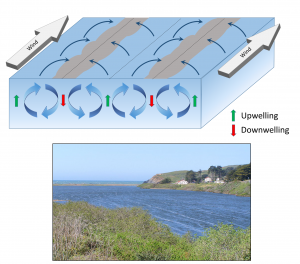9.7 Langmuir Circulation
One final type of wind-driven surface current occurs on a smaller scale when the winds blow in a consistent direction at relatively high speeds. Underneath these strong winds, water flows in a series of parallel corkscrew patterns called Langmuir cells (Figure 9.7.1 top). Each of the cells may be several meters wide and several meters deep, and adjacent cells rotate in opposite directions. While the overall direction of the corkscrew motion is in the direction of the wind, the rotation of the cells is roughly perpendicular to the wind direction. A divergence zone is created where the surface of the neighboring cells are rotating away from each other, and there is a degree of upwelling between the cells. Where the surface water of neighboring cells is rotating towards each other, a convergent zone is formed, with a region of downwelling between the cells. These alternating regions of divergence and convergence often take debris, foam, or algae floating at the surface and concentrate them along the convergence zones, creating long slicks running parallel to the wind direction (Figure 9.7.1 bottom).

corkscrew circulation patterns formed parallel to strong winds; they only extend a few meters below the surface (9.7)
process by which deeper water is brought to the surface (9.5)
process by which surface water is forced downwards (9.5)

